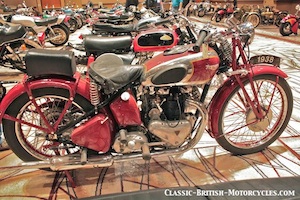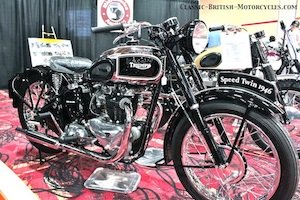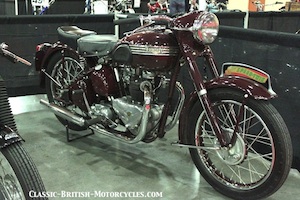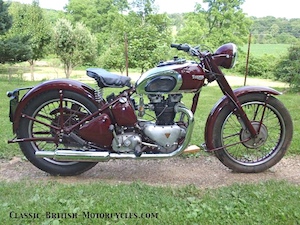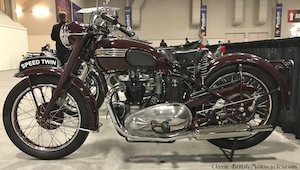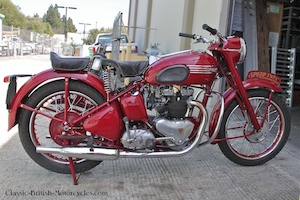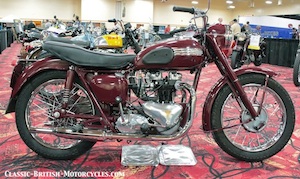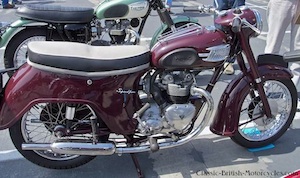TRIUMPH SPEED TWIN CHANGES THE WORLD!
From their earliest inception through the 1930s, most classic British motorcycles were single-cylinder designs with a few V-twins thrown in for sidecar duty. But the problem with both these configurations is vibration and a lot of it. As bikes grew in displacement and power output and the engine speed (RPM) began to climb, the vibes turned wicked, impacting engine life and rider comfort. Many things were tried but nothing could quell the forces of that one big piston flying around the cylinder at high speed. Along comes Edward Turner, fresh off of designing the Ariel Square Four. Triumph had been purchased by Jack Sangster in 1936, and he also owned Ariel, and Turner came along with the deal. His first job was to address the vibration issue, and he took a totally new direction with it. He split the displacement into two cylinders rising and falling together on a 360-degree crankshaft. He called it the parallel twin and it became the 1938 Triumph 500 Speed Twin, and it literally changed the motorcycle world overnight.
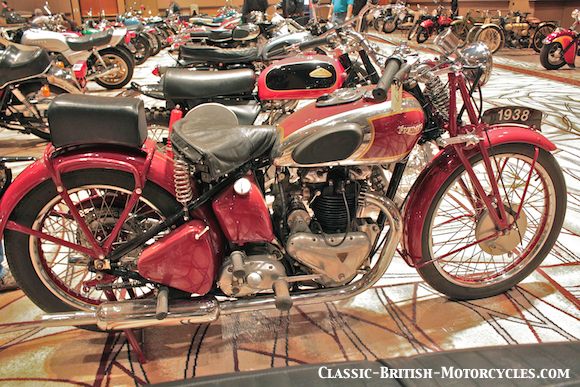
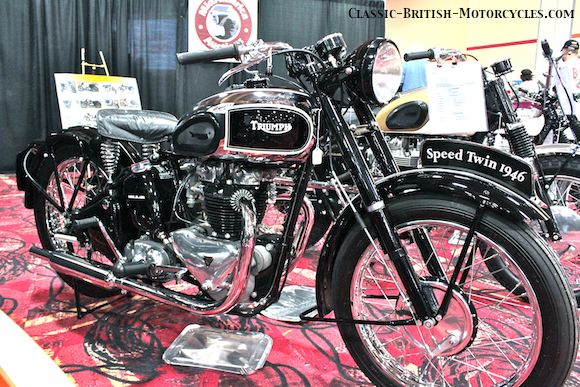
TRIUMPH SPEED TWIN BECOMES THE MODEL
After its introduction, virtually every other British motorcycle maker wanted their own parallel twin (now being called the “vertical twin”). But World War II intervened and it wasn’t until civilian production resumed after the war that this new crop of competing vertical twins. BSA was first up in 1946 with their 500cc A7 twin. It took until 1949 for the next batch of 500 twins, the Norton Model 7, the Matchless G9 and the Royal Enfield Meteor. By 1950, Triumph had already punched out the 500 to 649cc making the first Triumph 650. The race was on. As before, all the other British marques rushed to follow Triumph’s lead, each boring and/or stroking their 500 twins out for bigger displacement. And it all started with the Triumph Speed Twin.
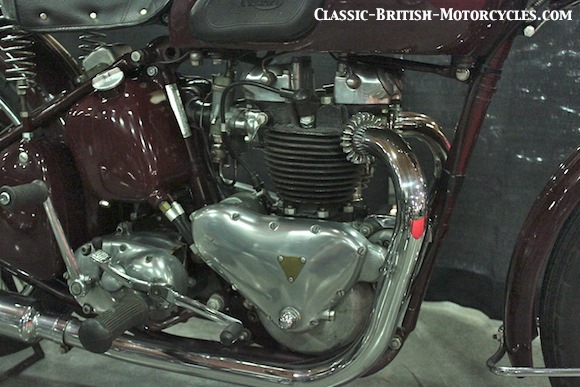
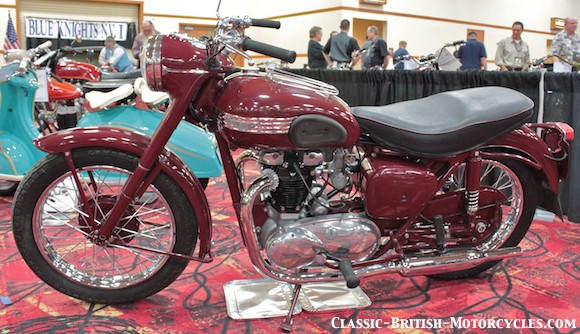
TRIUMPH SPEED TWIN EVOLUTION
When the Triumph Speed Twin was launched in 1938, it was a top-of-the-line sport bike. Just one year later, they were already hopping it up. With hotter cams and higher compression, the new T100 Tiger became the new hot rod Triumph, supplanting the Speed Twin as Triumph’s top-line model. In 1950, the 500 got punched out to a 650 with the new 6T Thunderbird, which itself then became Triumph’s premium model, permanently relegating the little 500s to second-class status. Then in 1953, the new 650 got the “Tiger Treatment” (ie: bigger cams, higher compression) and became the T110 Tiger, now the new hotrod Triumph and it’s current reigning top-dog. In 1956, Triumph created the new alloy “Delta Head” and with it a new bike, the TR6, the new premium bike. Next up was the dual-carb 650 Bonneville, and it became Triumph’s permanent premium model for the rest of its history. Each time one of these new models supplanted the last, the humble 5T Speed Twin got bumped further and further down the ladder. It was clearly Triumph’s ‘base-model’ heavyweight twin. There was nothing cheaper or lowlier in the lineup.
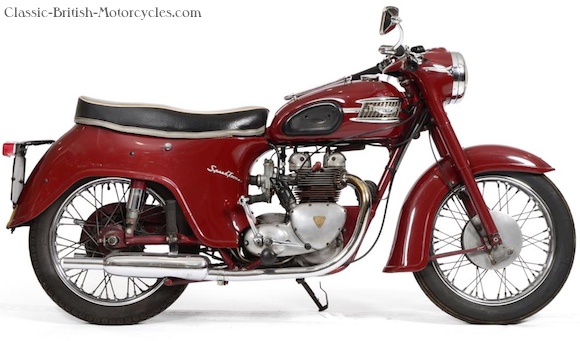
TRIUMPH’S ‘BATHTUB’ BIKES
There was a trend in England to enclose bikes back in the mid-1950s due to the rainy riding conditions in the British Isles. It was meant to shield the inner working of the bike from the elements. Unfortunately, the moisture still found it’s way in, now out of sight inside these enclosures, and did it’s rust-thing anyway. Triumph jumped on board in 1959 with the 350cc Twenty-One and the 500cc Speed Twin. The bulbous bodywork quickly earned the nickname “Bathtub Triumph”. Within a few years it became obvious that Americans hated the look and so with every passing model year, the ‘bathtub’ got smaller until it was gone by the final year of the Triumph Speed Twin in 1966.
Triumph Speed Twin YEAR-BY-YEAR
The second year of Edward Turners seminal vertical twin that set the standard for motorcycles for decades to come.
Right after WWII, Triumph got right back to making fast, styling parallel twins. It was a true market leader.
The feisty 500 parallel twins were among the fastest, best-handling motorcycles that money could buy at that time.
1948 5T SPEED TWIN
Minor changes & improvements, but largely carried over: rigid frame, telescopic forks, 500cc parallel twin & awesome performance for the day.
1954 5T SPEED TWIN
Mostly carried over from earlier 5Ts, but with sprung rear hub. Swing arm was coming…just not yet.
The Speed Twin evolved into the base model 500 twin, behind the Triumph Thunderbird and Triumph Tiger.
Triumph’s entry-level 500 twin, with unit-construction & full “Bathtub Bodywork”.
Check out these TRIUMPH BOOKS
Triumph Motorcycles: The art of the motorcycle
The Complete Book of Classic and Modern Triumph Motorcycles 1937-Today (Complete Book Series)
Triumph Motorcycles: From Speed-Twin to Bonneville
Triumph Bonneville and TR6 Motorcycle Restoration Guide: 1956-83
British Motorcycles Triumph (Little Books)
Triumph Motorcycles in America
McQueen’s Motorcycles: Racing and Riding with the King of Cool
Triumph Motorcycle Restoration
Illustrated Triumph Motorcycles Buyer’s Guide: From 1945 Through the Latest Models (Illustrated Buyer’s Guide)
Tales of Triumph Motorcycles and the Meriden Factory
Hinckley Triumphs: The First Generation (Crowood Motoclassic)
For more like these, visit our
TRIUMPH BOOK STORE
 |
PLEASE BUY MY NEW E-BOOK HERE Click here to buy now: |



